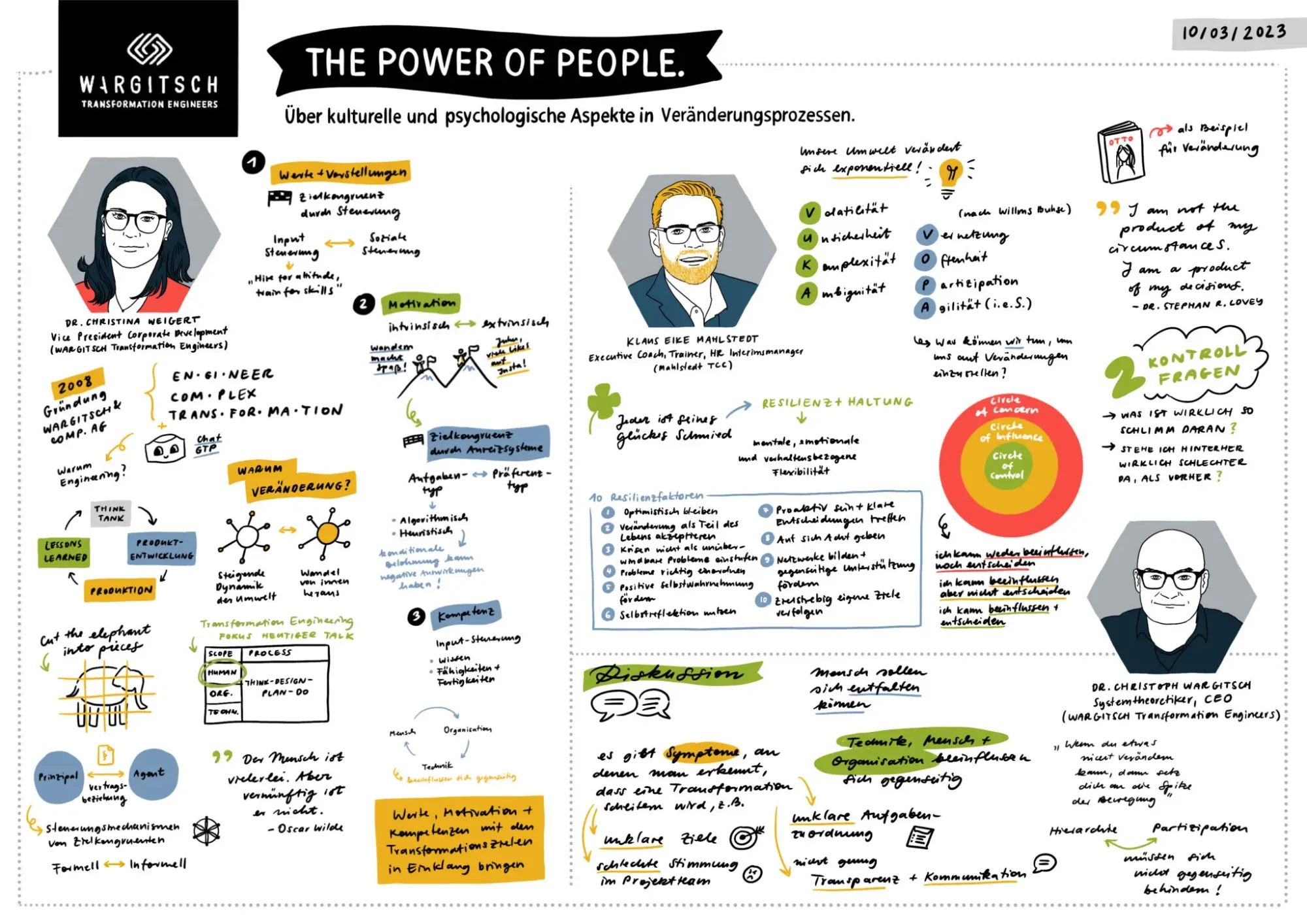Our first Transformation Talk 2023 focused on cultural and psychological aspects in change processes. In interesting keynotes and an exciting discussion round, the WARGITSCH Transformation Engineers shed light on this topic together with the audience.
If transformations in complex systems are to succeed, not only individual elements have to be considered – an expanded focus is necessary to include the entire system. In the long term, change projects can only be successful if everything is coordinated. To obtain the most holistic possible approach, the WARGITSCH Transformation Engineers examine the dimensions “people”, “organization” and “technology”. We addressed the first of these dimensions in our first Transformation Talk 2023: “The Power of People. On cultural and psychological aspects in change processes”.
Reduce resistance and create inspiring visions
Since people are in tension of corporate change and in constant interaction with organization and technology, the question rightly arises in transformation projects: How can people be optimally included in change processes? If insufficient attention is paid to this question, a chain reaction with further challenges and problems can quickly occur, even leading to the failure of the entire transformation. Consequently, the consideration of psychological aspects in transformations has become essential in modern business management. This is how resistance is reduced and an inspiring vision is created. During our Transformation Talk, the three speakers illuminate from their very own perspectives, how the influence of people – the power of people – is reflected in the world of work.
Klaus Eike Mahlstedt, executive coach, trainer, HR interim manager.
Dr. Christoph Wargitsch, systems theorist, CEO, host
Dr. Christina Weigert, VP Corporate Development
Complex Transformation Engineering – what’s that and how does it work?
Dr. Christina Weigert, expert for New Work and organizational management, provides the technical introduction to the wide-ranging topic of the transformation dimension “people” with three definitions of terms:
- Engineer: "A scientifically thinking and working person capable of skillfully arranging diverse aspects."
- Complexity: "The intricacy and interrelationship of many interconnected parts."
- Transformation: "The noticeable change in form, nature, and appearance."
To make transformation projects more successful, creative solutions should be used in this area, which also include a high degree of precision, logic and adaptability. Building on this, WARGITSCH pursues the transformation engineering concept:
Think Tank > Product Development > Production > Lessons Learned
As a part of this approach, ideas and knowledge are first generated in the think tank. The knowledge gained from this is incorporated into product development and thus also into the actual production (the work with customers). “Lessons learned can then be filtered from our day-to-day work and then flow back into the think tank,” Weigert explains. A cyclical approach, in other words, in which the phases are repeated in a cycle. “These four phases of the transformation engineering approach also incorporate the principles we stand for and work with.” Weigert also had an answer to the question of why such special approaches are needed in the first place and why so many companies need to change.
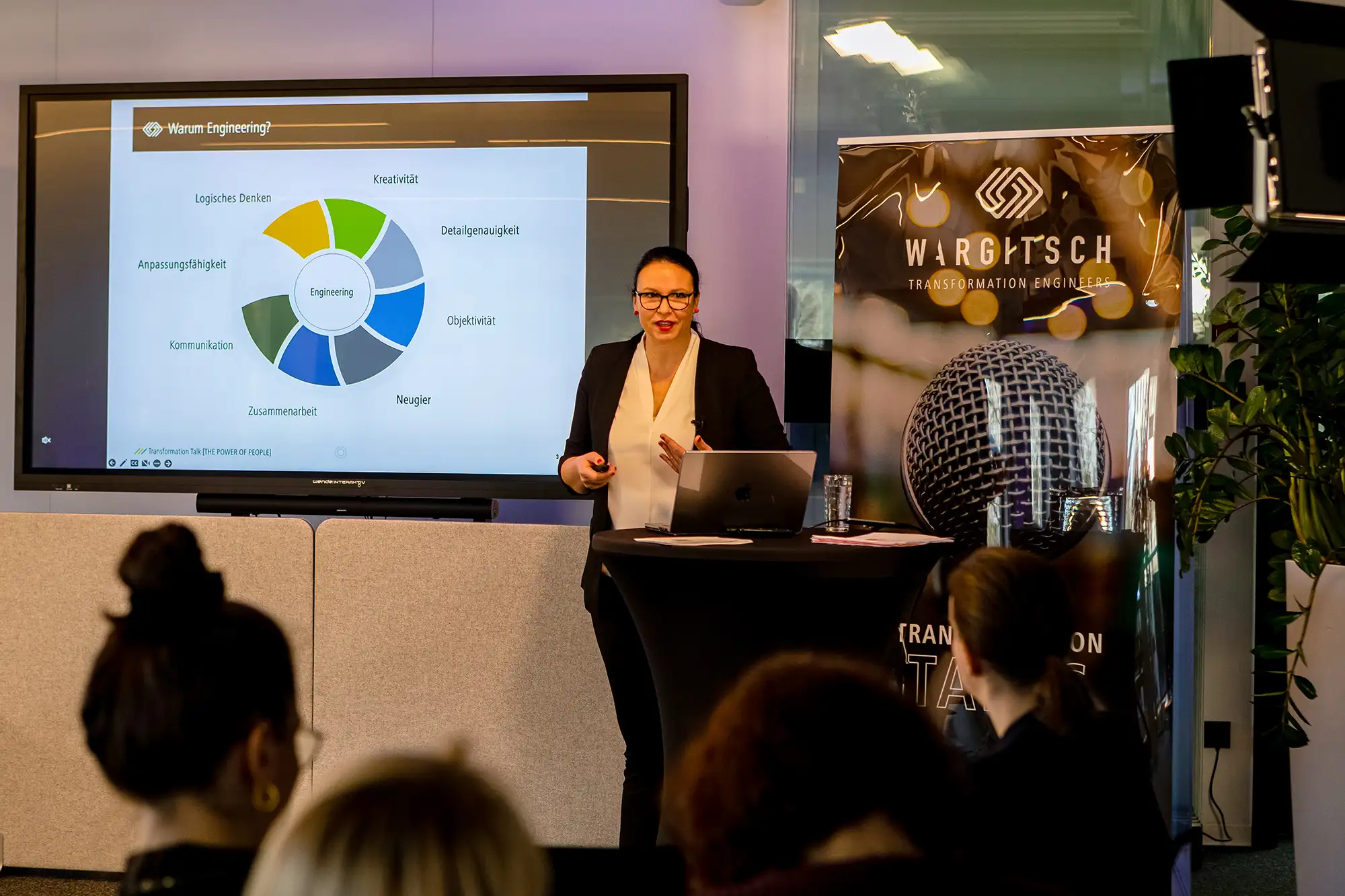
Of the big gray elephant and various control mechanisms
“Increasing connectivity in our society also means greater dynamism, and this in turn requires companies to be adaptable at the political, economic, social, technological, ecological and legal levels,” Weigert explains, adding, “transformations can be thought of as a big gray elephant that we cut into pieces. The complexity is reduced and divided in its entirety so that system elements can be viewed in transformation. Specifically, this is reflected in the four phases of our transformation engineering framework: think, design, plan, do.”
"The fundamental problem of organizations is to achieve cooperation between several individuals or units that pursue only partially congruent goals. Ensuring cooperation is a primary function of organizational control."
(Ouchi, 1979)
Accordingly, the issue of control is central to transformation projects. Of course, certain control mechanisms are present in every company, but their characteristics and nature often differ drastically: from formal to informal control with many individual forms and variations of control. This leads us to the (self-)control of the human being. Weigert cites the values and ideas, motivations, and competencies as influencing factors. An important way of successfully influencing these factors in transformation projects is the so-called input control, in line with the motto “hire for attitude, train for skills”. A form of management can take place here with the help of strength orientation and targeted recruiting. On a social level, it is also possible to support people in change processes by creating and internalizing consensual values and principles and by communicating transparently and constructively. Another way to manage workers: “Motivation and incentives. These can be intrinsic or extrinsic. An incentive system for goal congruence in companies ties in with performance appraisals and rewards. Each employee responds to other incentives, such as monetary incentives, a participatory way of working, or praise and recognition,” Weigert explains, continuing, “people cannot be viewed in isolation when it comes to change, but through the interactions also with the environment and technology, including all interfaces and interdependencies.”
Conclusion of Dr. Christina Weigert's kexnote presentation:
- If you don’t change, you may be changed.
- Even complex problems and situations can be unraveled, with the help of the appropriate methodology and tools.
- If we look at transformation in conjunction with the human factor, values, motivation, and competencies must be brought into line with the transformation goal.

Am I really worse off afterwards than before?
“Our environment is changing exponentially,” notes Klaus Eike Mahlstedt. He is coach, trainer, HR interim manager and brings his expertise on the “power of people” to the first Transformation Talk in 2023. In his keynote speech, he asks the following questions to the participants in the audience on site: 1. Who feels ready for change? 2. Who feels well supported by leadership and colleagues? While only a few hands were raised in response to the first question, many more of those present identified with the situation when asked the second question. According to Mahlstedt, this is no longer a matter of course in today’s society. After all, we live in a VUCA world characterized by volatility, uncertainty, complexity and ambiguity.
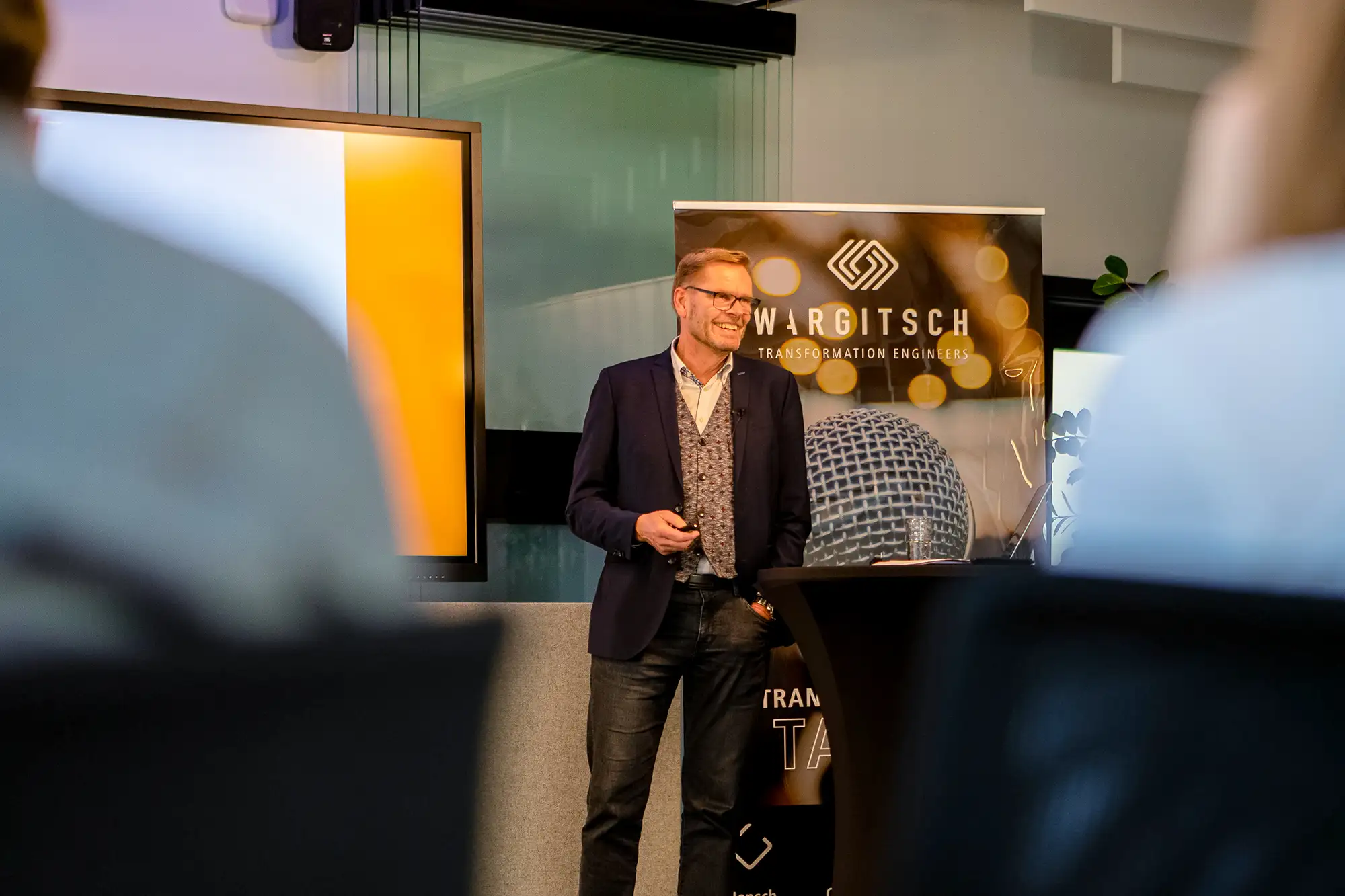
But how can these challenges be met? One answer to the VUCA world is Willms Buhse’s management method VOPA, which, like VUCA, is a German acronym and stands for networking, openness, participation and agility. As banal as these factors sound, they can be complicated to implement in reality. Mahlstedt therefore reveals two magic words to the participants: resilience and attitude, in keeping with the adage that “everyone is the architect of his own fortune”. The following recommendations for action (from the American Psychological Association) serve as a guide:
- Stay optimistic.
- Accept change as part of life.
- Do not classify crises as insurmountable problems.
- Classify problems correctly. *
- Promote positive self-perception.
- Use self-reflection.
- Be proactive and make clear decisions.
- Take care of yourself (keyword: Pareto).
- Build networks and encourage mutual support.
- Being purposeful in pursuing one's goals.

“These resilience factors will become increasingly relevant for us,” explains Mahlstedt, ending his keynote with a few simple but effective control questions: “What is actually so bad about a change? Am I really worse off afterwards than before?”
Start, fail, learn and succeed
After the two keynote speeches by Dr. Christine Weigert and Klaus Eike Mahlstedt, we move into the expert discussion together with Dr. Christoph Wargitsch. Weigert asks the two speakers exciting and practical questions to be able to grasp the human component in transformation projects even more clearly. The first question is what an initial assessment of success looks like concerning transformation projects, or whether such an assessment exists at all. Christoph Wargitsch comments: “It is difficult to predict success. Systems that are to be transformed are often complex and changing. Agility and adaptation are therefore essential. A path must not be stubbornly followed without paying attention to signals. Checkpoints must be set again and again, and corrections must take place.” Klaus Eike Mahlstedt agrees and adds: “Are the framework conditions and influencing factors different than expected? Then the project goal may have to be adjusted!”
Due to their many years of diverse experience in the project business, both Wargitsch and Mahlstedt are also able to share with the participants the experiences associated with failed projects. “Failure has never been admitted,” Mahlstedt reports. “A project was carried out, had no success, and then at some point it was seemingly finished. Shortly after, there were new projects to change the first one again. But an old, failed project was never communicated, and it was never reviewed. It is a human need not to address some things and to continue with ‘smoothing over differences’.
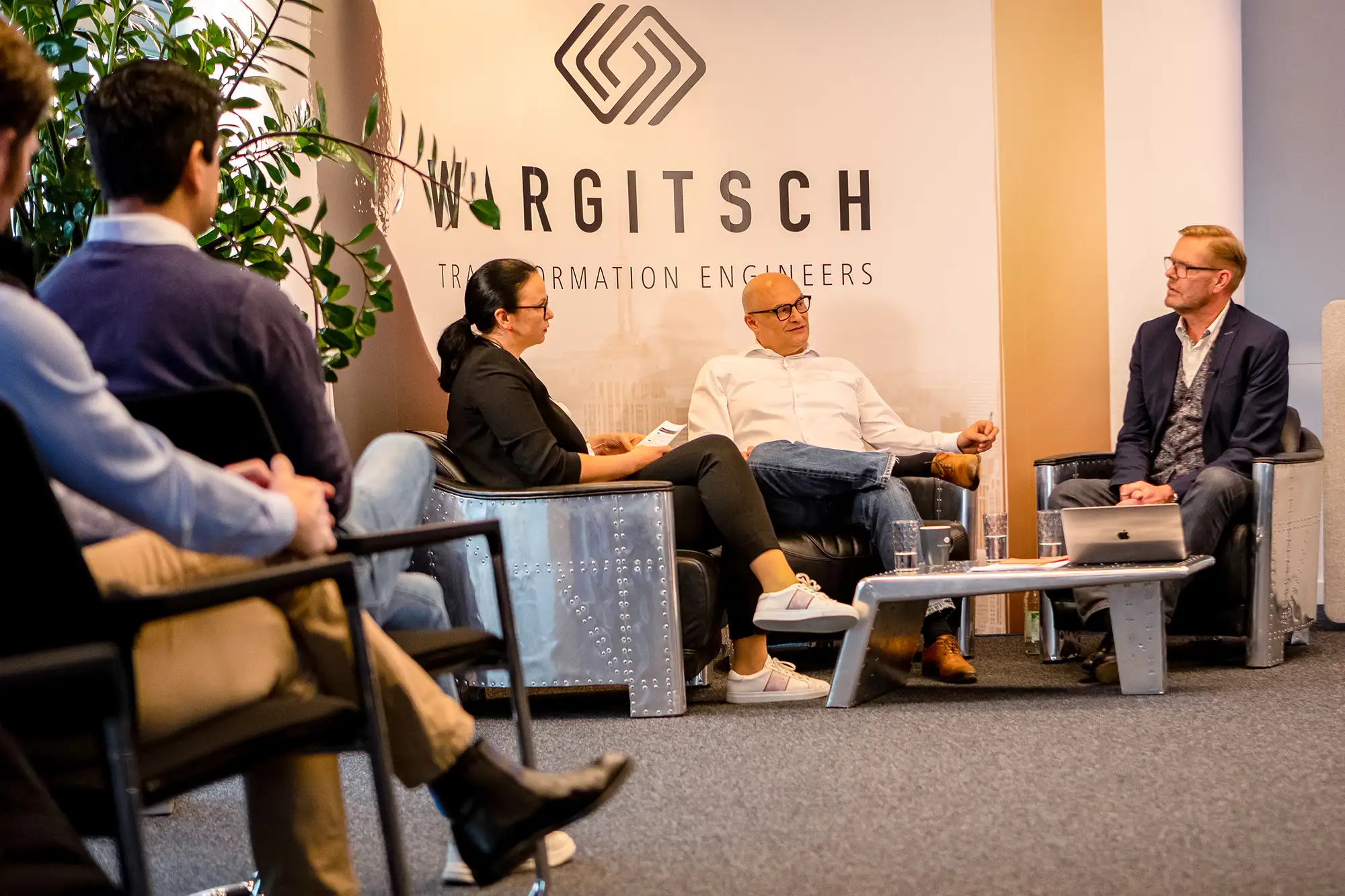
Transparency and communication can help here.” On the subject of failure, Christoph Wargitsch adds other key reasons: “The bigger a program is, the more likely it is to fail: fuzzy edges, no clear goals, split brains. But you can also learn from failed projects. With the help of a learning cycle, because even after a painful, expensive journey, such a program can end successfully.”
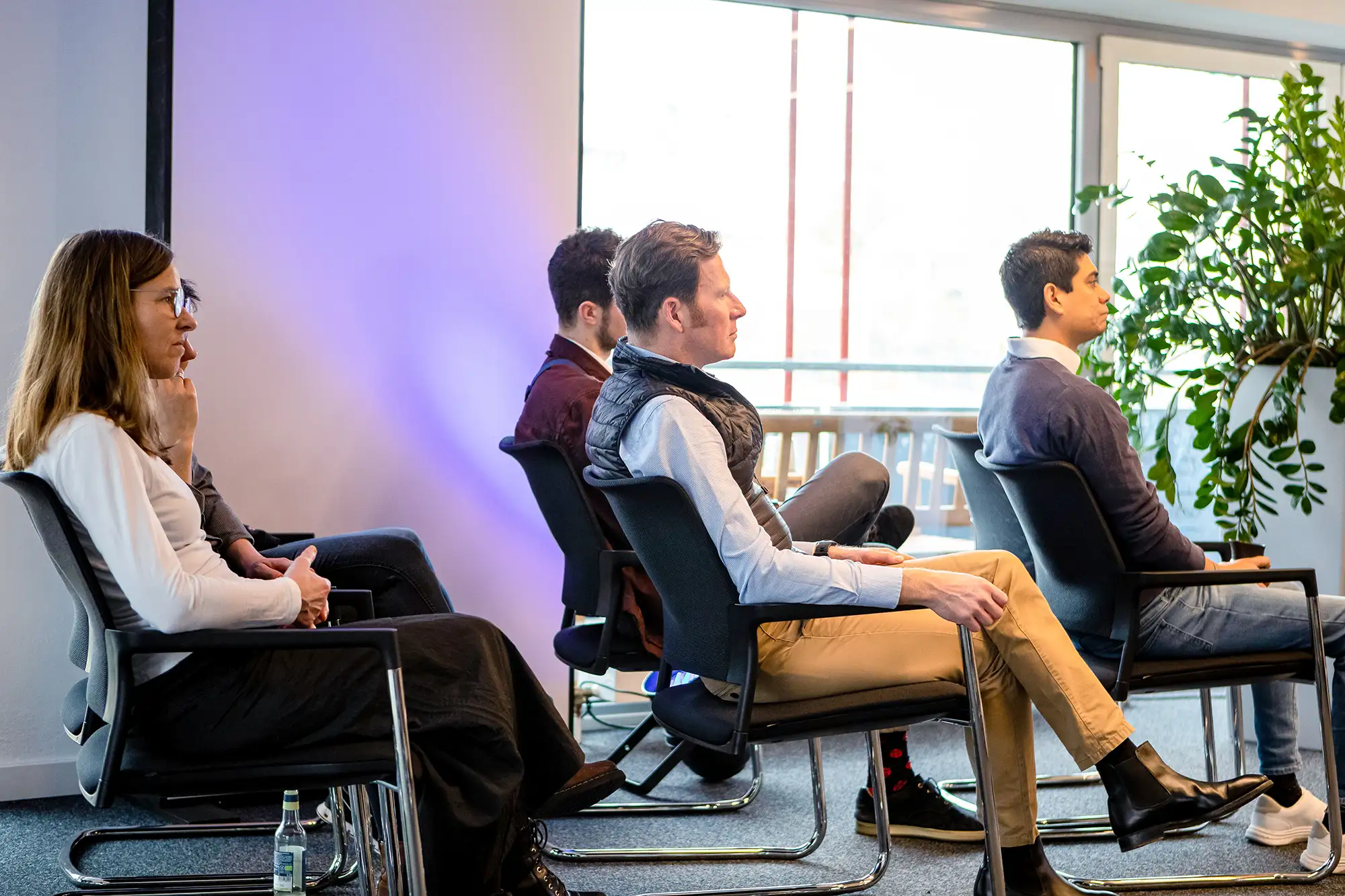
Between free spaces, hierarchy and organization
Last but not least, Dr. Weigert addresses the two experts on the interdependencies between people, organization and environment. “When many people come into a new system, I can anticipate certain consequences and offer free spaces. So, on the one hand, people can have an effect on the organization. On the other hand, people should be adjusted to technology to prepare them for their daily tasks. For example, people should be prepared and accompanied with regard to the topic of Artificial Intelligence.” Eike Mahlstedt adds the following: “Interdependencies always mean positive and negative influence. If you can’t prevent something, put yourself at the forefront of the movement. Keyword: attitude! How do I program myself through my mindset to adapt to change?”
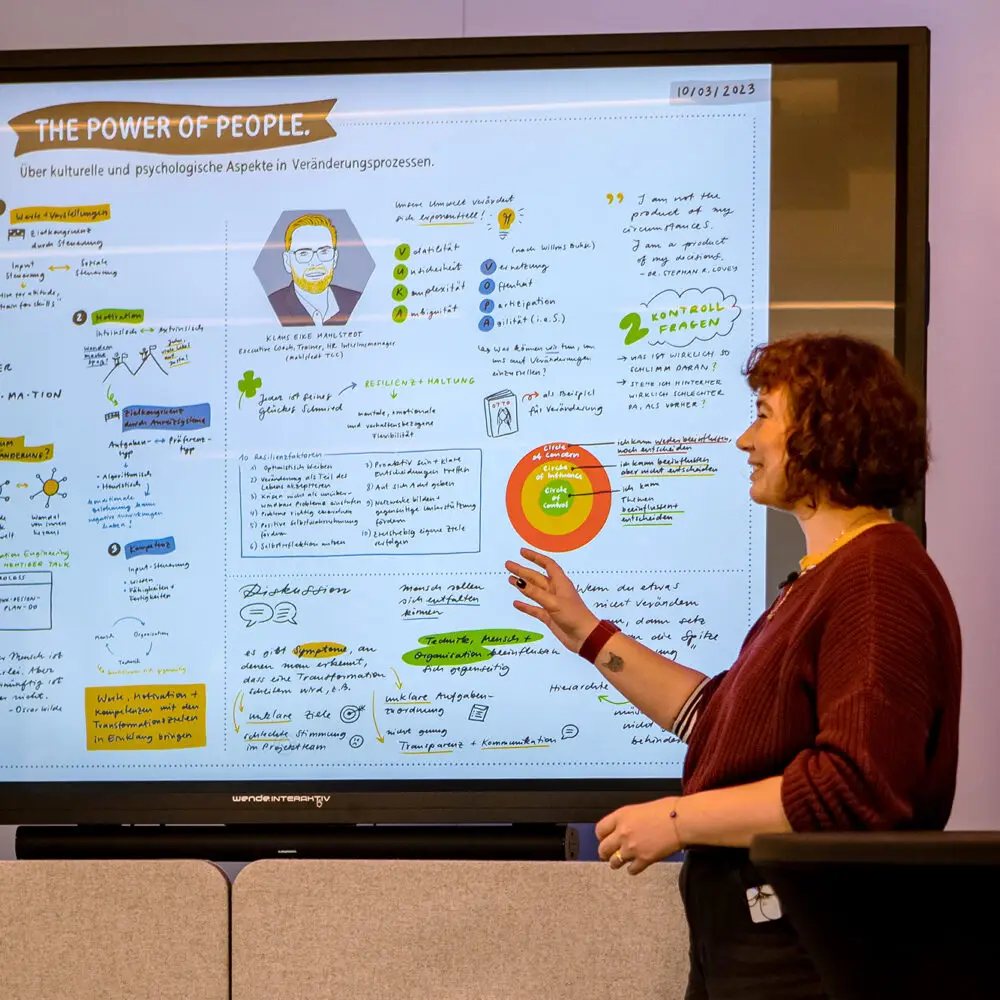
One change of today relates to the needs in the employee market. Less hierarchies and more participation are demanded. What do the two experts have to say about this? “There will always be changes, especially among the different generations,” says Wargitsch. “Hierarchies and participation are not contradictory. Hierarchies can mean structure, and within this structure you can then create free space for participation. Too much freedom can also be too much if there is no structure and no overview of the task area. Here, the following is important: I have to respond to each individual with their respective individual needs.” Mahlstedt agrees: “Yes! One thing must always be clear, namely the organizational framework. Who has what responsibilities, competencies, and accountablities? Because, agile organizations are not hierarchy- and organization-free spaces.”
